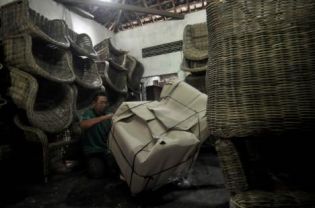Trade with Africa, South America key to maintain growth, minister says

Jakarta Globe | January 04, 2013
Trade with Africa, South America key to maintain growth, minister says
Faisal Maliki Baskoro
Indonesia is looking to boost exports to Africa, South America and South Korea in order to balance slowing demand from the United States, Europe and China.
Trade Minister Gita Wirjawan said during his visit to the Jakarta Globe on Thursday that he was expecting the trade deficit to continue in 2013 as imports of capital goods continued to rise while the United States and Europe, two of Indonesia’s biggest export destinations, were still showing no signs of recovery in the near future.
“Exports to Africa and South America are showing significant growth. What we need to do now is to increase the base of our market there,” the minister said in an exclusive interview.
As of November 2012, the trade deficit had accumulated to $1.3 billion, compared to the surplus of $25.5 billion in the same period a year earlier. Exports to the US, Europe and China fell by 6.9 percent, 11.7 percent and 2.8 percent respectively.
Gita said this trend would likely continue in 2013, but the current deficit account would be maintained at below 3 percent. As of the third quarter last year, the deficit stood at 2.4 percent.
“Around 65 percent of our exports are commodity-based. Slow demand from the US, Europe and China is likely to continue affecting prices,” he said.
“Imports of capital goods last year increased by 10 percent, while consumption of goods dropped. This is a positive shift in import trends, because in the long run the capital goods will create added value to our products,” he added.
Gita also said that Indonesia was making positive progress in Comprehensive Economic Partnership Agreement (CEPA) talks with South Korea. He predicted that the free-trade agreement could be materialized by August.
“South Korea has shown that it is serious about investing here,” he said.
The agreement aims to increase trade between the two countries to $50 billion by 2015 and $100 billion by 2020, from about $30 billion in 2011. Meanwhile, investment by South Korean companies in Indonesia quadrupled to $1.2 billion in 2011 from $328.5 million in 2010, led by steelmaker Posco and tiremaker Hankook.
Indonesia wants to expand its market, but in order for Indonesian products to be readily accepted in new markets, Gita said, Indonesia needs to seek international recognition that its products are environmentally sustainable.
Indonesia will host the Asia-Pacific Economic Cooperation conference and the World Trade Organization meeting this year and Gita said that Indonesia would bring environmental issues to the table, as well as promote trade with least-developed countries.
“We will try to put palm oil and rubber into the environmentally friendly goods list. The two products were previously rejected by the [US] Environmental Protection Agency [EPA]. On top of that, we will promote the use of green cars and increase agriculture productivity,” he said.
Gita also said that he would propose trade facilitation and tax exemption for products coming from least-developed countries to the WTO agenda.





